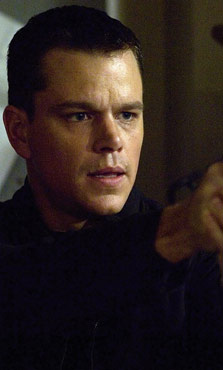 The joys of “The Bourne Supremacy” are all mundane. That is to say, rather than trying to wow the audience with the usual array of spy jargon and technological sorcery, director Paul Greengrass and writer Tony Gilroy have carved a terse, substantial, and well reasoned-out plot from Ludlum’s novel. For every eyeroll-inducing line like “Bourne popped up on the grid!”, there are numerous examples of humble, boring old information hunting: phone numbers, train schedules, hotel rooms, paper trails. The joys of “The Bourne Supremacy” are all mundane. That is to say, rather than trying to wow the audience with the usual array of spy jargon and technological sorcery, director Paul Greengrass and writer Tony Gilroy have carved a terse, substantial, and well reasoned-out plot from Ludlum’s novel. For every eyeroll-inducing line like “Bourne popped up on the grid!”, there are numerous examples of humble, boring old information hunting: phone numbers, train schedules, hotel rooms, paper trails.
My favorite props were the rumpled pizza boxes in the corner of the CIA ops center, an obvious detail nearly always forgotten in spy movies with war rooms that look like the TV section of Circuit City scrubbed germless by fastidious scientists. I was reminded of “Chinatown”, in which a byzantine plot was unraveled by a series of humdrum discoveries, some of which were as difficult as going to the library.
All of this works brilliantly in the form of Matt Damon’s amnesiac spy. Damon plays the character as a foil to the James Bonds of the cinematic world. Rather than having it all puzzled out, coolly waiting for the clock to tick the hour, Bourne constantly improvises. His escape from the German authorities at the train station is exciting because his first response to danger, it seems, is movement. No time to figure things out; he is hardly a master plotting an elegant chess solution.
Bourne’s quick thinking always solves the most exigent problem first without jumping ahead, creating suspense out of nominally dull action. Damon masterfully conveys the dual nature of Bourne’s identity: he is simultaneously hunter and hunted. Muscle-bound and baby-faced, Damon’s very physique communicates the hard fact of his character—he is a tender-faced killing machine.
Amply supported by a splendid cast, including Joan Allen and Brian Cox (who is making a sterling career playing villainous bureaucrats), “The Bourne Supremacy” is, like its predecessor, a compact affair that eschews Hollywood pyrotechnics for Seventies-style espionage verite. Most of the bigger ideas don’t resonate; it doesn’t matter much, for instance, that Ludlum’s Cold War setting is here just a footnote to an old Soviet swindle. What matters more is the modest reinvigoration of old clichés, including the climactic car chase.
The movie ends on an aptly somber note, daring to allow Bourne to reach the logical conclusion of his self-discovery in a scene that cleverly channels the ending to Conrad’s “Heart of Darkness”—with Kurtz, not Marlowe, visiting the Intended. It’s a fitting coda for a character who can’t even pretend he’s anything other than an assassin. The picture of Bourne atop a roof, sniper rifle trained on his superiors, is sneakily disturbing. It’s an image of blowback germane to recent American history, starting with Oswald and continuing through Bin Laden. Though it may be a quick glance, “The Bourne Identity”‘s greatest assset is its willingness to look its subject matter squarely in the eye. |